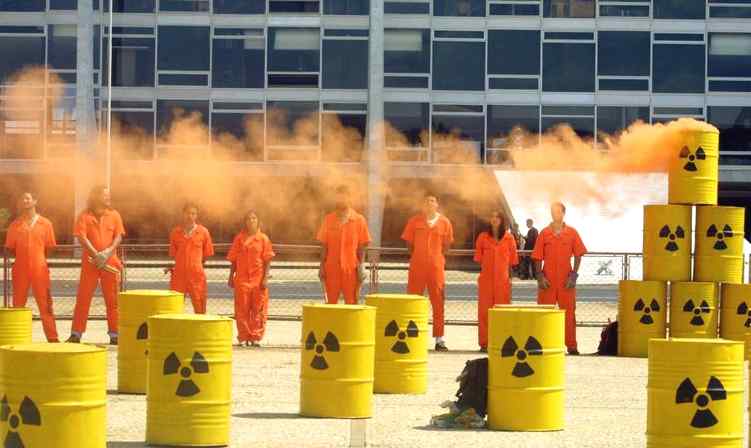
January 11, 2008
http://www.ens-newswire.com/ens/jan2008/2008-01-11-091.asp
TAKOMA PARK, Maryland, January 11, 2008 (ENS) - A dozen national organizations, joined by 68 state and local grassroots groups from across the country, filed comments with the U.S. Department of Energy Thursday in opposition to the high-level radioactive waste repository planned for Yucca Mountain, Nevada.
The groups also oppose shipping thousands of tons of nuclear waste through 45 states to Yucca Mountain located 90 miles northwest of Las Vegas.
This marks the latest effort by Yucca Mountain opponents, some of whom have been active against the planned facility for nearly three decades.
Yucca Mountain is located in a desert on federal land adjacent to the Nevada Nuclear Test Site in Nye County, Nevada. It is about 90 miles northwest of Las Vegas, Nevada, the fastest growing metropolitan area in the United States.
DOE began studying Yucca Mountain in 1978 to determine whether it would be suitable for the nation's first long-term geologic repository for over 72,000 metric tons of spent nuclear fuel and high-level radioactive waste now stored at 126 sites around the nation.
In October 2007, the DOE announced it was seeking to double the size of the Yucca Mountain repository to a capacity of 135,000 metric tons.
The Department of Energy, DOE, has pledged to file its long-delayed construction and operating license application to the U.S. Nuclear Regulatory Commission by June 30.
"The Bush administration’s rash rush to begin the Yucca licensing proceeding is a blatant attempt to make the dump a done deal before the next, potentially anti-dump, president enters the White House," said Kevin Kamps of Beyond Nuclear, a national watchdog on nuclear power and radioactive waste issues.
"Shipping tens of thousands of high-level radioactive waste trucks, trains, and barges through 45 states and the District of Columbia risks severe accidents and terrorist attacks," said Kamps.
"This could release catastrophic amounts of deadly radioactivity in major population centers, representing potential Mobile Chernobyls and dirty bombs on wheels rolling past the homes of millions of Americans," Kamps warned.
The coalition urged DOE to thoroughly analyze the negative impact on property values along all road, rail, and waterway routes across the continental United States that would be used to ship wastes to Yucca.
Its submission states, "Courts, juries, and socio-economic studies have found that property values decrease significantly near declared radioactive waste transport routes. DOE must identify in detail all routes it plans to use for shipping wastes to Yucca…and should hold hearings in every state thus impacted."
Besides transport risks, the coalition exposed geological and environmental justice "show stoppers" at the Yucca Mountain Project.
The national groups filing comments include - Beyond Nuclear, Clean Water Action, Environment America, Global Network Against Weapons & Nuclear Power in Space, Greenpeace, Nuclear Age Peace Foundation, Nuclear Information and Resource Service, Peace Action, Physicians for Social Responsibility, Public Citizen, SUN DAY Campaign, and Women’s Action for New Directions.
The 68 regional and local groups hail from 27 states.
The groups object that Yucca Mountain is located above an earthquake fault line and that rainwater moves through the site even though it is located in an arid part of the country.
"DOE has known for over a decade that rainwater percolates relatively quickly through the proposed burial site, risking fast corrosion of the waste burial containers and release of catastrophic amounts of deadly radioactivity into the drinking and agricultural irrigation water supply below," said Kamps.
The coalition says the location of the facility is within the treaty lands of the Western Shoshone Indian Nation, as affirmed by the "Peace and Friendship" Treaty of Ruby Valley, signed by the U.S. government in 1863.
The groups say Yucca Mountain "violates environmental justice principles," an allegation supported by the United Nations Committee on the Elimination of Racial Discrimination.
In 2002, the Yucca Mountain site was approved by the Congress and President George W. Bush as the location for the nation's first permanent spent nuclear fuel and high-level radioactive waste geologic repository.
In 2006 the DOE agreed upon March 31, 2017 as the date to open the facility and begin accepting waste.
But in the 2006 mid-term elections, the Senate majority was won by the Democratic Party and Nevada Senator Harry Reid, a long time Yucca Mountain opponent, became Senate majority leader. Reid has said that he will continue to work to block completion of the project, which is opposed by the entire Nevada congressional delegation, and most Nevada state politicians.
Reid has said, "Yucca Mountain is dead. It'll never happen."
In the 2008 Omnibus Spending Bill, the Yucca Mountain Project's budget was reduced to $390 million.
Lacking a repository, however, the federal government will owe to the utilities that operate nuclear power plants somewhere between $300 and $500 million per year in compensation for failing to comply with the contract it signed to take the spent nuclear fuel by 1998. This cost is paid by U.S. taxpayers.
The DOE is moving ahead with preparations to license Yucca Mountain. On December 13, 2007 Ward Sproat, director of the DOE Director of the Office of Civilian Radioactive Waste Management, released two independent assessments of the Yucca Mountain repository program. Sproat says both reports concluded that the program's current quality assurance and engineering processes and procedures "are consistent with standard nuclear industry practices."





